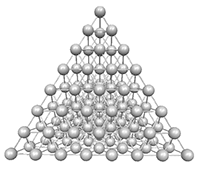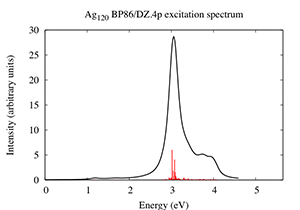A 120 atom tetrahedral silver cluster modeled with ADF
Professor Christine Aikens of Kansas State University and Professor George Schatz of Northwestern University and their co-workers have collaborated on a number of works exploring the electronic spectroscopy of metal nanoparticles with time dependent density functional theory using ADF. A recent report of this work was published in The Journal of Physical Chemistry C, in which they explored the optical absorption properties of silver nano-particles of various sizes.


Left: The tetrahedral Ag120 cluster. Right: The excitation spectrum.
Prof. Aikens and her colleagues were able to model such properties for nanoparticles ranging in size from 10 atoms up to the 120 atom tetrahedral nanoparticle depicted above. They were able to carry out such computations in a reasonable amount of time on 4GB compute nodes thanks in part to the fact that ADF takes advantage of the symmetry of molecules, even for TDDFT response calculations. The Aikens group has since extended its exploration of the properties of noble metal nanoparticles to clusters of gold atoms, for which the relativistic effects modeled through ADF’s ZORA method are known to be even more important.
C. M. Aikens, S. Li. and G. C. Schatz, From Discrete Electronic States to Plasmons: TDDFT Optical Absorption Properties of Agn (n = 10, 20, 35, 56, 84, 120) Tetrahedral Clusters. Journal of Physical Chemistry C, 112 (30), 11272 (2008).
Key conceptsADF nanoscience Relativistic DFT spectroscopy TDDFT UV/VIS